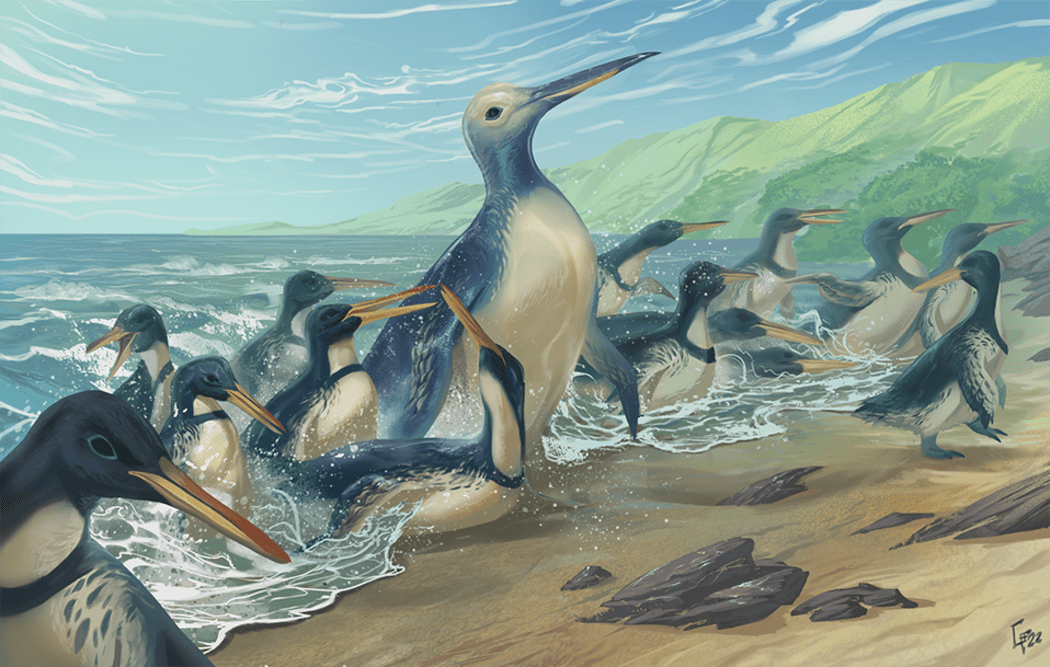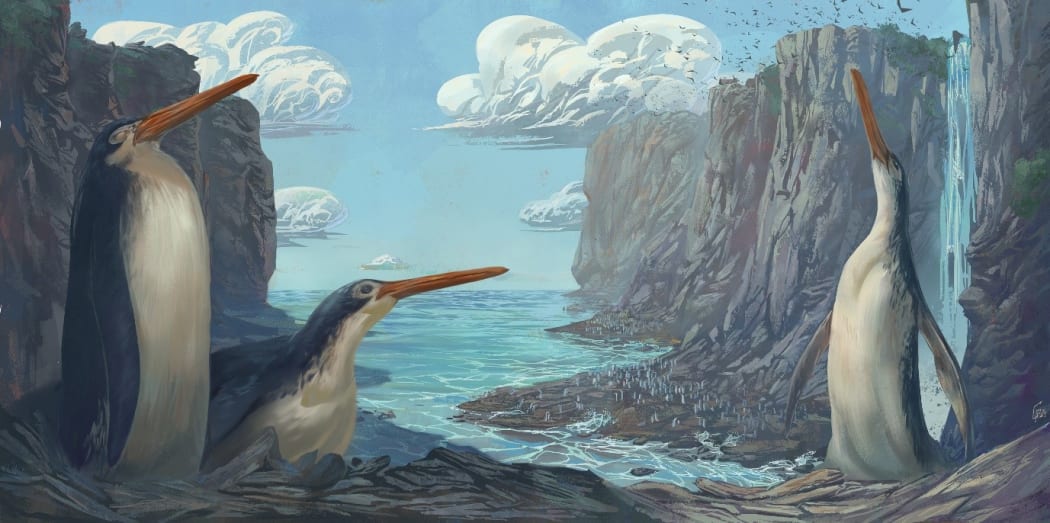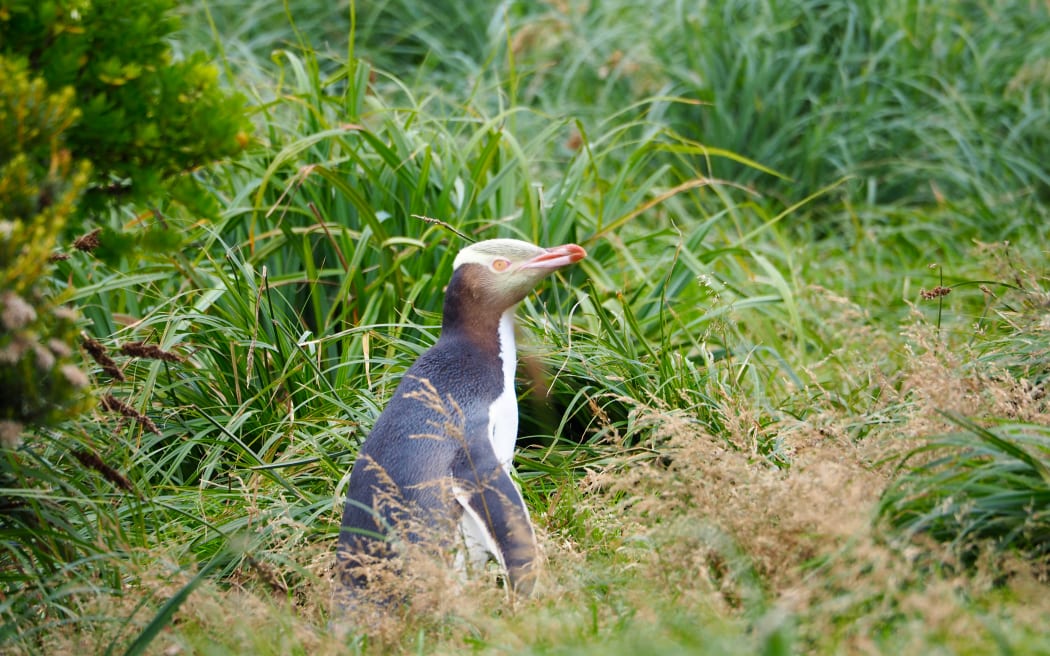Evolution spins out some crazy designs.
Bats that can hunt in the dark using echolocation, spiders that use water surface tension to detect prey, and rugby-ball-shaped birds who look like they are wearing formal attire as they dive through the water to hunt.
Marching penguins, dancing penguins, surfing penguins. These birds have found their niche in both the oceans, and on our movie screens.
What made penguins the beloved birds that they are today?

Concept image of the giant extinct penguin Kumimanu fordycei towering over other extinct penguins that were closer in size to modern-day emperor penguins. Photo: Simone Giovanardi
Follow Our Changing World on Apple Podcasts, Spotify, Stitcher, iHeartRADIO, Google Podcasts, RadioPublic or wherever you listen to your podcasts
From flying in air, to flying in water
Our story begins 62 million years ago. “I recognise that that’s just a number,” says Dr Daniel Thomas, of Massey University. “But to put that into context – at 66 million years, that is when the non-avian dinosaurs disappeared from the planet.”
Once a dinosaur-obsessed kid, Daniel continues to follow his passion, now with a focus on one of the descendants of avian dinosaurs. He studies penguin fossils and their evolution across time.
The earliest penguin fossils come from right here in Aotearoa, from North Canterbury. Dated to a mere four million years after the dinosaur extinction event – a blink of the eye in geological time – these bones indicate that early proto-penguins had already committed to life in water, although they may not have been very efficient divers.
Birds that fly in the air – like the once-ancestor of the penguin – have hollow bones. But these early fossil bones found in Canterbury are dense, better suited to diving under water.
Across the next 6–13 million years, the wings of these birds underwent significant changes. No longer were they able to tuck back in after a stroke, instead the joints would stiffen so that they effectively became fixed paddles, driven by the shoulder.

Dr Daniel Thomas is a vertebrate palaeontologist specialising in fossil penguins. Photo: Claire Concannon / RNZ
The time of the giants
Penguin evolution is constrained by many factors: the difficulty of ‘flying’ in dense viscous water, the issue of constant heat loss, the need to also go on land to breed. But that didn’t stop evolution from testing all the penguin size and shape possibilities within these constraints. And early on in penguin evolution, something interesting happened – penguins get very large.
The title of 'biggest’ for our modern penguins goes to the emperor penguin – about 1 metre tall and 30 kilograms in weight. But during their giant era, it is estimated that penguins got as tall as 1.3 metres, or possibly taller, and up to 150 kilograms in weight.

Concept image of the giant extinct penguin Kairuku waewaeroa. This fossil was discovered by school children as part of a Hamilton Junior Naturalist Club field trip to Kawhia Harbour. Photo: Simone Giovanardi
And then there was one
Throughout the penguin fossil record there is evidence of many different designs. In fact, there are far more penguin species in the fossil record than modern species.
But only one made it through.
The most recent common ancestor of all modern penguins is believed to have existed about 14 or 15 million years ago. That one ancestor has spawned the six genera (types) of penguins we have today. One of these penguin types can only be found in the subantarctic islands and South Island of Aotearoa.

A hoiho yellow-eyed penguin on the subantarctic Auckland Islands. Photo: Ellen Rykers
Listen to the episode to learn more about penguin evolution, and why New Zealand is a great place to study penguin fossils.
To learn more:
-
Find out about the lives of emperor penguins at Cape Crozier from episode 5 of the award-winning Voices from Antarctica series: Waiting for Emperors.
-
Fiordland crested penguins, or tawaki, live in the dense forest of Milford Sound. Alison Ballance learned some of their secrets in the 2017 episode Tawaki – the mysterious forest penguin.
-
The Megadyptes group once contained two species. Waitaha penguins and yellow-eyed penguins, or hoiho. Waitaha are now exctinct, and, unfortunately, the mainland population of hoiho has been in very serious decline for quite some time. It is thought that fishing competition, warming waters, avian diphtheria, and disruption to nesting sites have all impacted the birds, and recently they have also been affected by a severe respiratory disease.
-
In 2012 Alison Ballance spoke to Professor Ewan Fordyce about the Kairuku giant penguin fossils.


